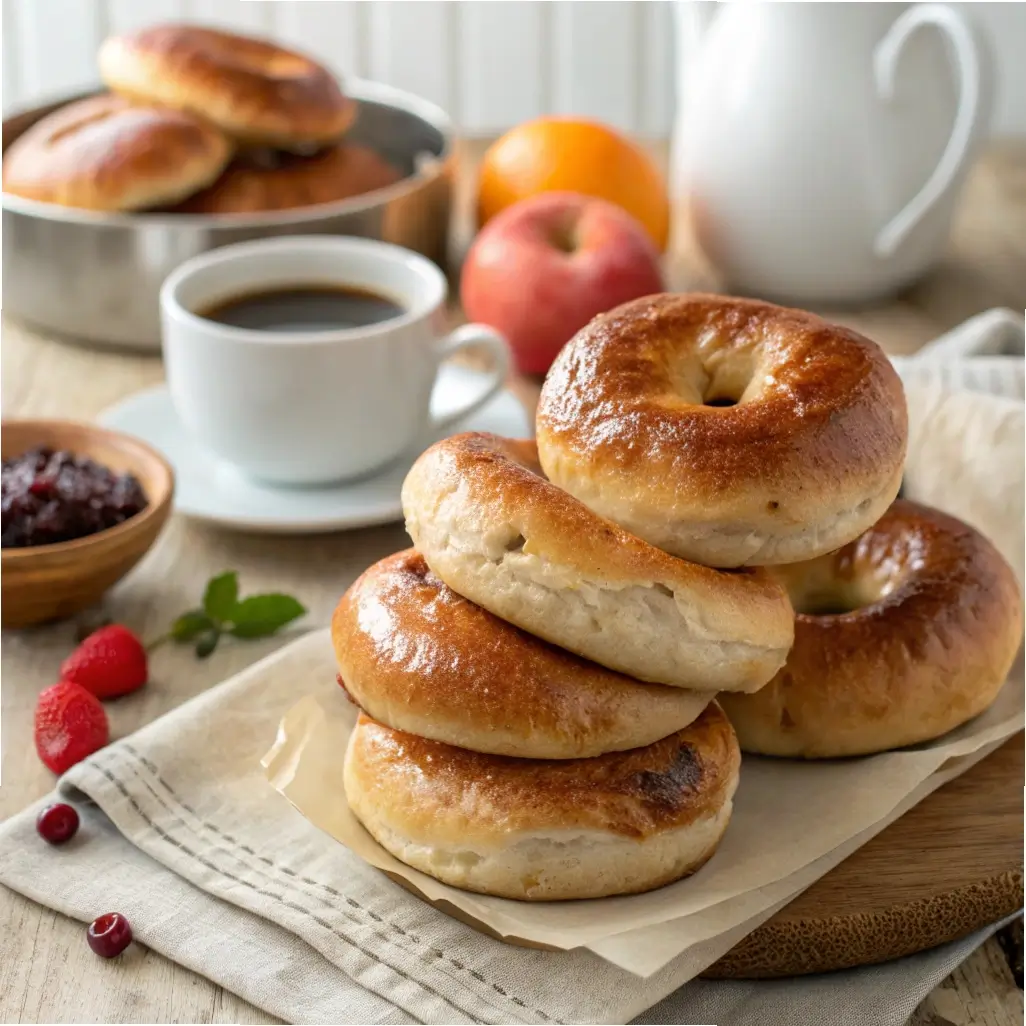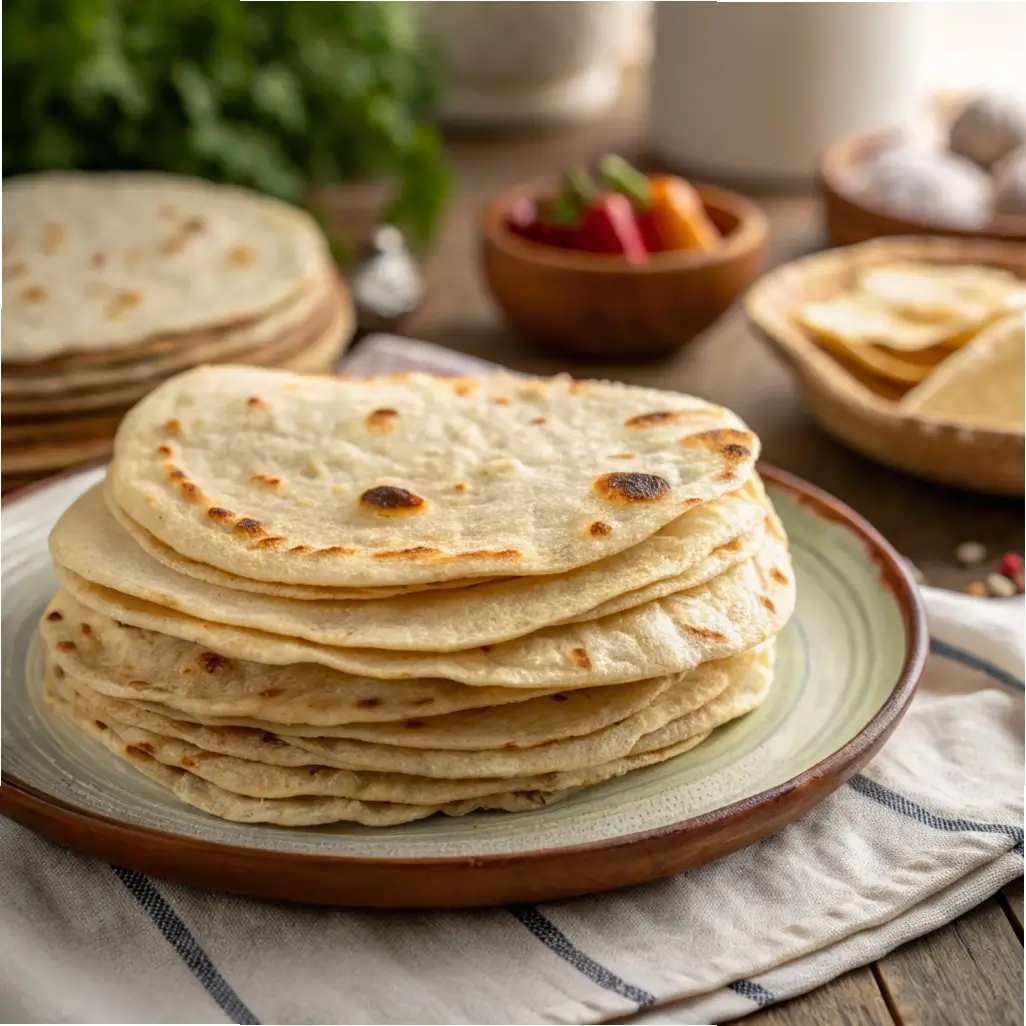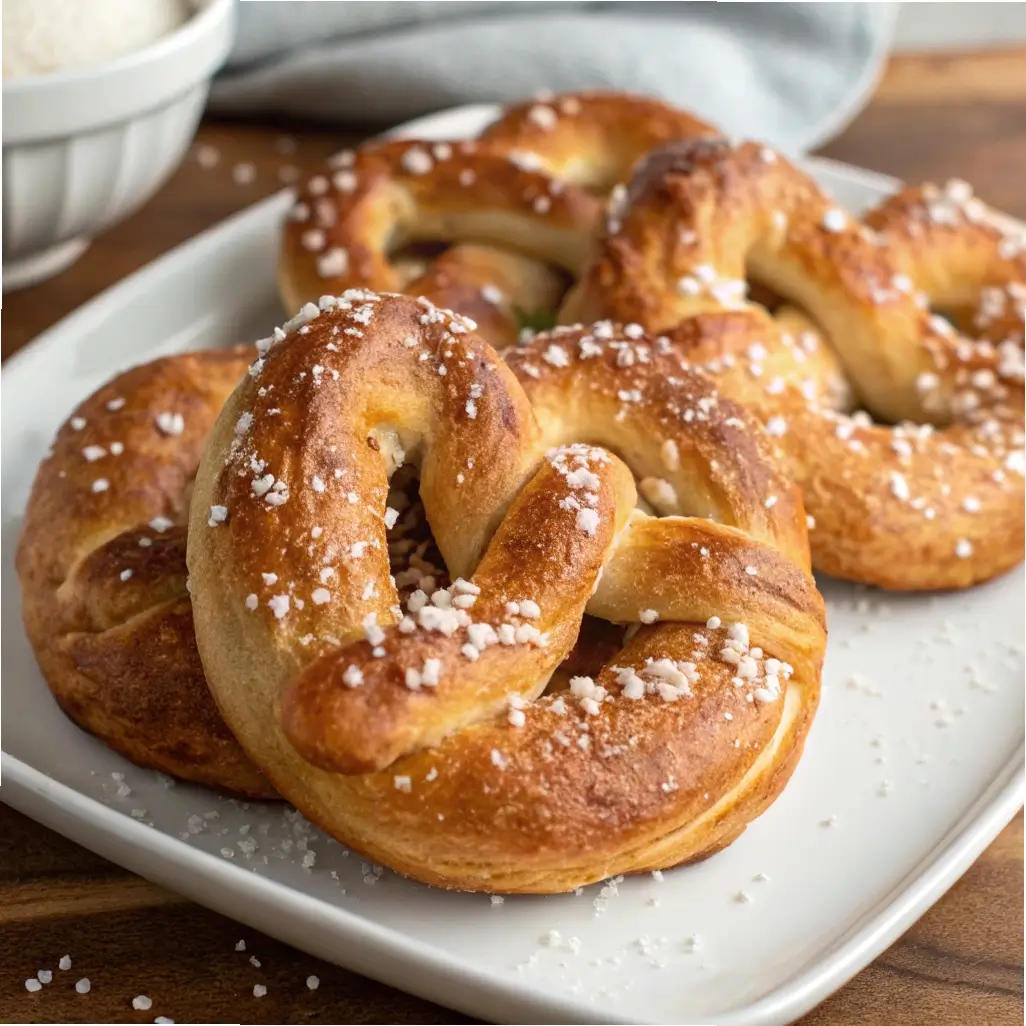Contents
- 1 How Discard Helps in Bagel Dough
- 2 Ingredients & Notes
- 3 Equipment You’ll Need
- 4 Step‑by‑Step Instructions
- 5 Tips for Best Bagel Texture
- 6 Flavor & Variation Ideas
- 7 Serving Suggestions & Pairings
- 8 Storage, Freezing & Reheating
- 9 Troubleshooting & Common Pitfalls
- 10 Frequently Asked Questions
- 11 Final Thoughts
Making bagels at home may sound intimidating, but with sourdough discard you can simplify the process and still end up with soft, chewy, golden bagels that rival the bakery. These sourdough discard bagels combine the tang and moisture of discard with a classic bagel texture that’s perfect for breakfast, brunch, or any time you crave a hearty, satisfying treat.
Unlike traditional long ferment bagels, this recipe is streamlined for convenience yet produces excellent results: good chew, nice crust, and delightful flavor. You don’t need fancy equipment—just your sourdough discard, basic ingredients, a pot for boiling, and an oven. The whole process can be done in under two hours (excluding any resting time).
In this guide, you’ll find:
-
Ingredient breakdown with tips
-
Step‑by‑step instructions, from mixing to boiling to baking
-
Flavor and topping variations
-
Serving suggestions and pairings
-
Storage, reheating, and make‑ahead guidance
-
Troubleshooting common issues
-
A FAQ section for clarity
Let’s dive in and get bagel baking!
How Discard Helps in Bagel Dough
Before the recipe, understanding the role of discard is useful:
-
Moisture and softness: Discard contributes hydration, helping prevent a dry crumb.
-
Subtle tang and depth: The mild acidity complements the slightly sweet and salty dough, enhancing complexity.
-
Texture boost: It helps with extensibility (stretchiness) which aids shaping and chew.
-
Convenience: You use unfed discard—no need to feed your starter just for this recipe.
Because sourdough discard varies in hydration and strength, you may have to adjust water or flour slightly. The recipe below gives a good baseline.
Ingredients & Notes
Here’s what you’ll need to make about 6 medium bagels (you can scale up or down):
| Ingredient | Amount | Purpose & Tips |
|---|---|---|
| Sourdough discard (unfed) | ½ cup (≈ 120 g) | Main liquid component; adds flavor and moisture |
| Warm water | ¼ to ⅓ cup (60–80 ml) | Hydrates dough — adjust as needed |
| Sugar or malt syrup | 1 tablespoon | Helps browning and yeast activation |
| Instant yeast | ½ teaspoon | Assists rise and structure |
| Salt | ¾ teaspoon | Flavor balance |
| Bread flour (or strong all-purpose) | 1 ½ to 1 ¾ cups (≈ 200–230 g) | Provides chew and structure |
| Optional: barley malt powder / honey / brown sugar | 1 teaspoon | For bagel flavor and sheen |
| Toppings: sesame seeds, poppy seeds, everything bagel blend, onion flakes, salt | As desired | To add texture and flavor |
Notes and Tips on Ingredients
-
Because discard hydration can vary, start with lower water and increase gradually.
-
Use quality bread flour if possible; it gives better chew with higher gluten.
-
A touch of sugar or malt helps with color and yeast activity.
-
Toppings should be lightly pressed into the surface before baking to adhere well.
Equipment You’ll Need
-
Large mixing bowl
-
Measuring cups and spoons
-
Dough scraper or spatula
-
Clean work surface for kneading
-
Kitchen towel or plastic wrap
-
Baking sheet with parchment or silicone mat
-
Large pot for boiling
-
Slotted spoon or ladle
-
Rack for cooling
Step‑by‑Step Instructions
1. Mix the Dough
-
In your mixing bowl, combine warm water, sugar (or malt syrup), and instant yeast. Let rest 5 minutes until foamy (if using).
-
Stir in sourdough discard and pinch of salt.
-
Gradually add flour, mixing until a rough dough forms. Adjust flour or water as needed to reach a tacky but manageable dough.
2. Knead
-
On a floured surface, knead the dough for about 6–8 minutes until smooth, elastic, and slightly tacky (not sticky). Add small amounts of flour if necessary, but avoid overdoing it.
-
Shape into a ball and place in a lightly oiled bowl, turning to coat. Cover and let rest for about 20 minutes (a short bench rest helps relax gluten).
3. Shape Bagels
-
After the rest, punch the dough down gently.
-
Divide into 6 (or more for smaller ones) equal pieces.
-
Roll each piece into a rope ~8–9 inches long.
-
Form a bagel shape: either press the ends together directly or overlap ends slightly and roll together to seal. Ensure a tight seal so the bagel holds shape.
-
Place shaped bagels on parchment or lightly floured tray, spaced apart. Cover loosely and let rest ~15 minutes to puff slightly.
4. Preheat Oven & Prepare Boiling
-
While the bagels rest, preheat your oven to 425 °F (220 °C).
-
Bring a large pot of water to a rolling boil. Add a tablespoon of sugar or malt to the boiling water (helps with crust). You may boil multiple bagels at once but don’t overcrowd.
5. Boil Bagels
-
Gently drop each bagel into the boiling water. Boil for 30–60 seconds per side (flip halfway) — the longer boil gives chewier crust.
-
Remove with slotted spoon and drain. Return to parchment‑lined baking sheet.
-
Immediately sprinkle with toppings (sesame, poppy, etc.) pressing gently to help them stick.
6. Bake
-
Bake in preheated oven for 18–22 minutes, until tops are golden brown and bottoms sound hollow when tapped.
-
If you want extra shine, brush with a little oil or diluted syrup after baking.
7. Cool & Serve
-
Allow bagels to cool on a rack (at least 10 minutes) before slicing — this helps finish the interior structure.
-
Serve with spreads, toppings, or toast as desired.
Tips for Best Bagel Texture
-
Proper boil time: A longer boil (45–60 sec each side) yields a thicker crust and more chew.
-
Hot oven: Baking at ~425 °F is ideal for crust development without overbaking.
-
Tight shaping: Good seams keep bagels intact during boil and bake.
-
Use parchment: It helps transfer and prevents sticking, especially when wet from boiling.
-
Test interior: Tap bottom or insert skewer for doneness.
-
Avoid overproofing: Don’t let bagels puff too much before boiling, or they lose chew.
Flavor & Variation Ideas
-
Everything bagel: Use everything bagel blend (sesame, onion, garlic, salt) as topping.
-
Cinnamon‑raisin: Fold cinnamon and raisins into dough; top with cinnamon sugar after baking.
-
Cheese bagel: Sprinkle dairy or non‑dairy cheese on top before baking.
-
Garlic herb: Brush bagels with garlic‑herb oil before or after baking.
-
Onion bagel: Mix finely chopped sautéed onion into dough or top with onion flakes.
-
Whole wheat / multigrain: Replace ¼–½ of flour with whole wheat or multigrain blend (expect slightly denser texture).
-
Seeded inside dough: Mix flaxseed, chia, sunflower seeds into dough for extra nutrition and texture.
Serving Suggestions & Pairings
-
Classic: toasted halves with cream cheese, butter, jam, or nut butter.
-
Savory: top with avocado, tomato, smoked salmon, or hummus.
-
Breakfast sandwich: egg + cheese + greens between slices.
-
Bagel toast: slice, butter, and top with garlic, herbs, or baked topping.
-
Serve fresh in a brunch basket with fruit salad, coffee, juices.
-
Use leftover bagels as dunkers for soups or stews.
Storage, Freezing & Reheating
-
Room temperature: Keep in a paper bag or loosely wrapped for 1–2 days (more airtight makes crust soggy).
-
Freeze: Slice halves or whole bagels, wrap well, freeze up to 2 months.
-
Reheat: Toast slices, or warm whole bagel in oven (~350 °F / 175 °C) for 5–8 minutes.
-
Revive stale bagel: Lightly dampen, wrap in foil, and warm in oven for 5 minutes.
Troubleshooting & Common Pitfalls
| Problem | Reason | Fix |
|---|---|---|
| Bagels too dense | Underproofed, too much flour, weak yeast | Allow full rise, measure flour carefully, use fresh yeast |
| Bagels fall apart in boil | Poor shaping or seams not sealed | Shape tightly, pinch seams, use parchment for support |
| Crust too soft / lacking chew | Boiled too little, oven too cool | Increase boil time, bake in hotter oven |
| Toppings fall off | Not pressed or wet surface dries too fast | Press toppings gently after boiling, bake soon after |
| Interior gummy or undercooked | Underbaked | Bake longer, test with skewer, ensure heat distribution |
| Bagels spread flat | Dough too slack or overhydrated | Reduce water slightly, tighten shaping, chill dough briefly |
Frequently Asked Questions
Will these bagels taste sour from the discard?
No — the tang is mild and adds nuance. The surfaces and toppings (sesame, onion, etc.) dominate the flavor profile.
Do I need to feed the starter before using the discard?
No — this recipe is designed to use unfed discard, so you don’t need to feed just for bagels.
Can I skip the boil?
Skipping the boil changes the texture significantly — the crust and chew will be much more like a roll than a bagel. The boil is essential for a proper bagel crust.
Can I make these gluten-free?
You can try using a gluten-free flour blend with binders, but expect differences in chew and texture. It will require testing and adjustment.
How do I know when they’re done baking?
The tops should be golden brown, and when you tap the bottom, it should sound hollow or light. The interior should be cooked—skewer test helps.
Can I scale this recipe up?
Yes — multiply ingredients proportionally. Use larger pans or multiple baking sheets, and slightly adjust rise and bake times.
Final Thoughts
These Easy Homemade Sourdough Discard Bagels give you the joy of baking bagels from scratch, with the added benefit of using your discard. Soft inside, chewy, flavorful — they’re perfect for breakfast, brunch, or any time you want a hearty, homemade treat.
Start with the base recipe, then try topping and mix-in variations. With practice, you’ll adapt to your own preferred chew, crust, and flavor profile. Enjoy the process, and enjoy your warm, chewy bagels fresh from your oven!





